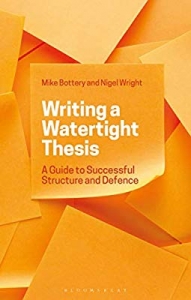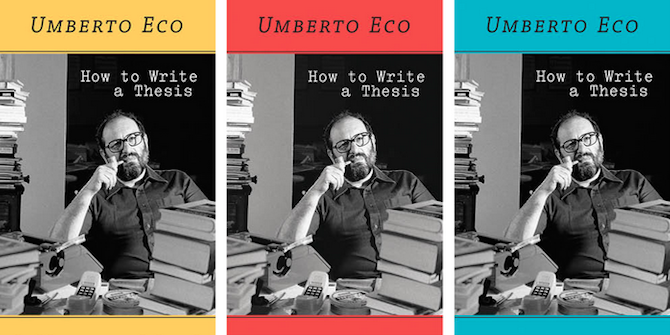In Writing a Watertight Thesis: A Guide to Successful Structure and Defence, Mike Bottery and Nigel Wright provide a framework by which research students will be able to structure both their thesis project and the journey required to carry a candidate to a successful endpoint. While the book offers useful and valuable advice to researchers at any stage in their PhD studies, Courteney O’Connor particularly recommends it to pre-candidacy and early stages doctoral candidates.
Writing a Watertight Thesis: A Guide to Successful Structure and Defence. Mike Bottery and Nigel Wright. Bloomsbury. 2019.
 Find this book (affiliate link):
Find this book (affiliate link): ![]()
Mike Bottery and Nigel Wright, in Writing a Watertight Thesis, have provided a framework by which research students will be able to structure both their thesis project and the journey required to carry a candidate to a successful endpoint. Having a coherent, logical and structured approach to the entire thesis journey is arguably the most important element of the ‘watertight’ thesis (1). The authors contend that the concept of the watertight thesis is applicable no matter the discipline or research design, because regardless of the field in question, a solid thesis structure and a coherent argument are crucial requirements of all (doctoral) theses (7). While different disciplines can and will vary in structural and content requirements, the fact remains that the doctoral project must still be ‘watertight’ according to these.
For those undertaking a more traditional PhD, the proposal is what decides whether you will be accepted into your desired programme; it also shows the university in question how you intend to answer an advanced research question and how clear your thinking already is on this topic (18). Chapter Two of the text not only outlines the important elements of the research proposal, but how the potential candidate can plan the proposal in a logical manner. The authors provide general guidance as well as specific instructions on how different elements – such as the writing of the Introduction; key contexts; central concepts and evidence to be gained; methodological approach and methods used; and the working title – can be approached and then refined (21-35).
How you structure the thesis itself is only one part of the overall structure of your doctorate. Bottery and Wright discuss the importance of three different areas in which a good structure is crucial to your success: academic time management; social time management; and supervisory time management (38). It may seem obvious, but the time you allocate to each ‘task’ necessary to the successful completion of the thesis itself is not the only draw on your time, mental capacity and physical ability. You also need to consider, and assign appropriate weighting to, the other areas of your life wherein you have serious or ongoing commitments. Obviously, the time management specific to your academic survival (and hopefully success) is incredibly important, but it will affect and be affected by your social commitments, and also the relationship you have with your supervisor. The authors quite rightly assert that you need to make time for, and develop, both of these areas, and provide focused questions and exercises to help the potential candidate explore what good time management and structuring looks like, and the methods according to which these insights may be applied in their own journey (45-47).
Having discussed the challenges and potential solutions of both gaining admittance to, and structuring your journey through, a doctoral programme, the authors turn to perhaps the most important step in starting the PhD project: identifying and then refining the major research question (MRQ). The authors note that it should most definitely be a question, not just a statement of research intent: a research project that is undertaken over an extended period of time needs to be directed by a specific question, to which the purpose of the doctorate is to provide the answer(s) (60). In this the authors are absolutely correct.
Following on from the discussion of the MRQ, the authors tackle the identification and refinement of the sub-research questions (SRQs) that will form the elements of the answer to the MRQ. As with the previous section, following a discussion of the definition, creation and purpose of SRQs, Bottery and Wright offer a series of exercises designed to aid the researcher in identifying and refining the SRQs for their own thesis project. This was very useful, and something that needs to be focused on and emphasised to a greater degree to candidates in the early stages of their thesis journey. Properly articulated, SRQs direct your research and refine your thinking on your field and question – their utility cannot be overstated. Working out in what order your SRQs should be addressed affects the overall balance of the thesis and the answer(s) to the MRQ, so the emphasis the authors give to this process is well deserved.
In addition to the usual focus questions and exercises, this section also contains a discussion of how the lessons in this volume can be applied at the various stages of the thesis during which you may have found their book, and for this I applaud them. Writers of similar texts don’t often address candidates further into their research, so it was pleasing to see this issue covered by Bottery and Wright. A subsequent discussion on balancing the relative lengths of your chapters was also well done and, despite not offering hard and fast rules (and being the better for it), provides solid advice on this often under-emphasised but very important consideration.
Chapters Seven through Nine form the authors’ deconstruction and discussion of how to go about structuring the actual chapters of the thesis, split into groupings of ‘early’, ‘middle’ and ‘end’ chapters. The section of the early chapters’ passage I found to be most useful was an analogy between the Introduction chapter and getting suitcases onto a train (98-103). Effectively, your Introduction should be packaged (and delivered) into five suitcases that are loaded onto the train (i.e. presented to the reader) in such a way that you articulate your interest in the research area and why it is important; your positionality and how it may affect your understanding of the research; your major research question; your sub-research questions; and the order in which you will address these questions (and why). Keeping these ‘luggage tags’ in mind will help you to write an effective Introduction (104-105). This is genuinely one of the better-explained and -articulated discussions of an Introduction that I have read thus far: it is easy to understand and seems simple and effective to apply yourself.
Similar exercises and focus questions follow in the ‘middle chapters’ consideration, which analogises methodological processes and sections to a ‘bridge’, connecting your research purpose and your results and conclusions (111-12). This section does a good job of describing the importance and applications of methodological approaches, tools and techniques, though I would have liked to see the authors expand on the variety of techniques available to the doctoral researcher within both quantitative and qualitative approaches. Chapter Nine offers insights into the structuring and general content you should expect to see in the final sections of the thesis (124-37). The distinctions made between results and analysis, discussion and the conclusions and recommendations chapters are helpful and appear to be a very good guide to follow. The authors also provide a list of twenty ‘structural leaks’ to check for before you begin to celebrate having finished your write-up, which I would sincerely suggest printing out and hanging on the office wall to any and all doctoral candidates (134-36).
The final section of the text, covering Chapters Ten to Twelve, narrows in on the importance and requirements of the examiners, preparation for the viva and publication, respectively. Writing a Watertight Thesis is overall a well-written and very useful volume for research candidates. While I would recommend the text more to the pre-candidacy or early stages doctoral candidate, there is information throughout that is useful and valuable to researchers at any stage of their doctoral project. It is written engagingly in an approachable manner, and with focus questions and exercises that are clearly articulated and easy to follow. A worthwhile addition to the research candidate’s bookshelf.
Note: This review gives the views of the author, and not the position of the LSE Review of Books blog, or of the London School of Economics. The LSE RB blog may receive a small commission if you choose to make a purchase through the above Amazon affiliate link. This is entirely independent of the coverage of the book on LSE Review of Books.
Image Credit: (Photo by Olia Gozha on Unsplash).









1 Comments